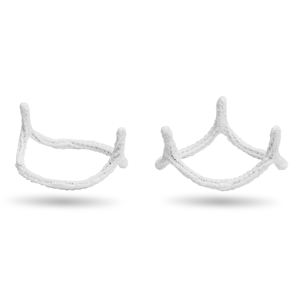Bicarbon™
CORCYM has developed an advanced solution for aortic valve replacement (AVR): The Bicarbon™ product line offers a range of mechanical valves designed to minimize the risk of complications.
- Coating technology: Bicarbon™ is the only valve on the market that features a Titanium housing coated with Carbofilm™. This coating technology improves hemocompatibility, reduces the risk of pannus formation, and fosters gentle tissue ingrowth.
- Curved leaflets and 80-degree opening angle, combined with aerofoil housing profile: Bicarbon™ facilitates laminar blood flow, leading to reduced shear stress and hemolysis, as well as a lower risk of clotting.
- Two-open chimney: Bicarbon™ ensures efficient passive washing of the hinges. Together with the other features, this contributes to an extremely low thrombogenicity.
Bicarbon™ Slimline
- partially supra-annular aortic valve
- sizes 17-27 mm
Bicarbon™ Fitline
- intra-annular aortic valve
- sizes 19-31 mm
Multinational registry 2022
“The results of the SURE–AVr Registry demonstrated that the proposed Lower–INR Target is safe and feasible after Bicarbon aortic mechanical valve replacement. The low–intensity anticoagulation strategy is associated with a low risk of hemorrhagic events without any increase of thromboembolic complications.”
Santarpino et al. Eur Heart J Suppl 2022. DOI: 10.1093/eurheartj/suac012.357
Clinical study 2019
“Methods: Retrospective study of 1377 patients who had replaced with SBP [Sorin Bicarbon™ prosthesis] from May 1998 to December 2008 at Ho Chi Minh Heart Institute, Viet Nam.
...
Conclusions: SBP had shown very good results in long term and still have a reliable mechanical valve.”
Van. Ann Thorac Cardiovasc Surg 2019. DOI: 10.5761/atcs.oa.18-00223
Clinical study 2010
“LOWERING-IT trial established that the proposed LOW-INR target is safe and feasible in low-risk patients after bileaflet aortic mechanical valve replacement. It results in similar thrombotic events and in a significant reduction of bleeding occurrence when compared to the conventional anticoagulation regimen.”
Torella et al. Am Heart J 2010. DOI: 10.1016/j.ahj.2010.05.005







